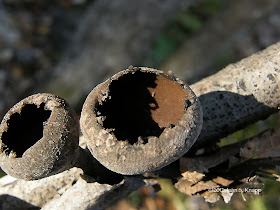March 10th, 2012. On our recent trip to the Piedmont NWR a couple of weeks ago, we saw Dimpled Troutlilies just beginning to bloom. We figured that they’d be full bloom now so we drove back down to photograph them.
We took a slightly different route from our last trip. We took the route from GA-83 south on Starr Road through the Oconee National Forest into the NWR. We drove through Tribble Fields to the bridge over Little Falling Creek and then north to Pond 2A. We returned the way we’d come and then took the first road on the right down to the Round Tree – Juliette Rd, drove east and then back into the NWR on the first road on the left. From there we drove north to the intersection with Sugar Hill Road, turned west and forded Stalking Head Creek. We then drove north and took the first road on the right to ford Stalking Head Creek again, east past a small pond and southeast to meet Sugar Hill Road again and then east to GA-11.
The last surprise on this trip was an accidental discovery. I’d gone down the slope to look at the small patch of Mayapple plants and started to wander around looking for trilliums. And, at the base of a tree nearby, I found some…
 Fungi. Five of them in a neat row. The largest was about 1-1/2 inches in diameter.
Fungi. Five of them in a neat row. The largest was about 1-1/2 inches in diameter. A closer view. At first I thought they were puffballs. They were growing along a short section of a fallen branch; I wondered if they were attached to it. So I picked up the branch carefully. Three of the fungi remained attached to the branch. Upon closer examination I realized they were cup fungi. The others were growing in the leaf litter. A ‘Google’ search revealed that they are Urnula craterium, known by the common names Devil’s Urn or Black Tulip fungus.
A closer view. At first I thought they were puffballs. They were growing along a short section of a fallen branch; I wondered if they were attached to it. So I picked up the branch carefully. Three of the fungi remained attached to the branch. Upon closer examination I realized they were cup fungi. The others were growing in the leaf litter. A ‘Google’ search revealed that they are Urnula craterium, known by the common names Devil’s Urn or Black Tulip fungus. Views of these fungi from the side
Views of these fungi from the side A closer view showing the spore-bearing surface inside the cup. There’s a nice diagram of the structure of the cup fungi here.
A closer view showing the spore-bearing surface inside the cup. There’s a nice diagram of the structure of the cup fungi here.I’ve seen very few cup fungi so this was an exciting find for me and these were beautiful specimens. Interestingly, upon reviewing the photo of the trilliums I posted here, I can see two more of these fungi at 4 o’clock to the trilliums. One is quite obvious and the other is sitting at an angle and not so obvious; these were not growing on wood. Apparently it’s quite common in the eastern United States in the Spring. I’ll have to wander around in the leaf litter in the woods more often.
Click on an image to view a larger image
Identification resources:
- Jim Conrad, Backyard Nature: Devil's Urn (Urnula craterium)
Related Posts:
- Piedmont National Wildlife Refuge: Late Winter Surprises (Part 4)
- Piedmont National Wildlife Refuge: Late Winter Surprises (Part 3)
- Piedmont National Wildlife Refuge: Late Winter Surprises (Part 2)
- Piedmont National Wildlife Refuge: Late Winter Surprises (Part 1)
- Piedmont NWR: The First Dimpled Troutlily (Erythronium umbilicatum) Of Spring

I'm fond of fungi, too. Great shots!
ReplyDeleteThanks. We went back last weekend and found a bunch more. They're older now and not as pretty. I'll post more pics of them in a few days.
ReplyDelete